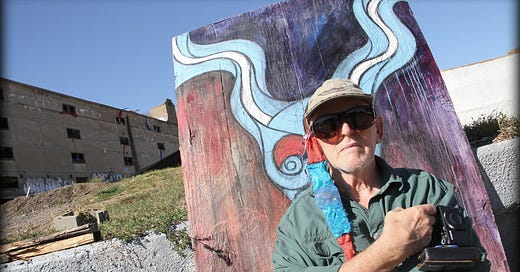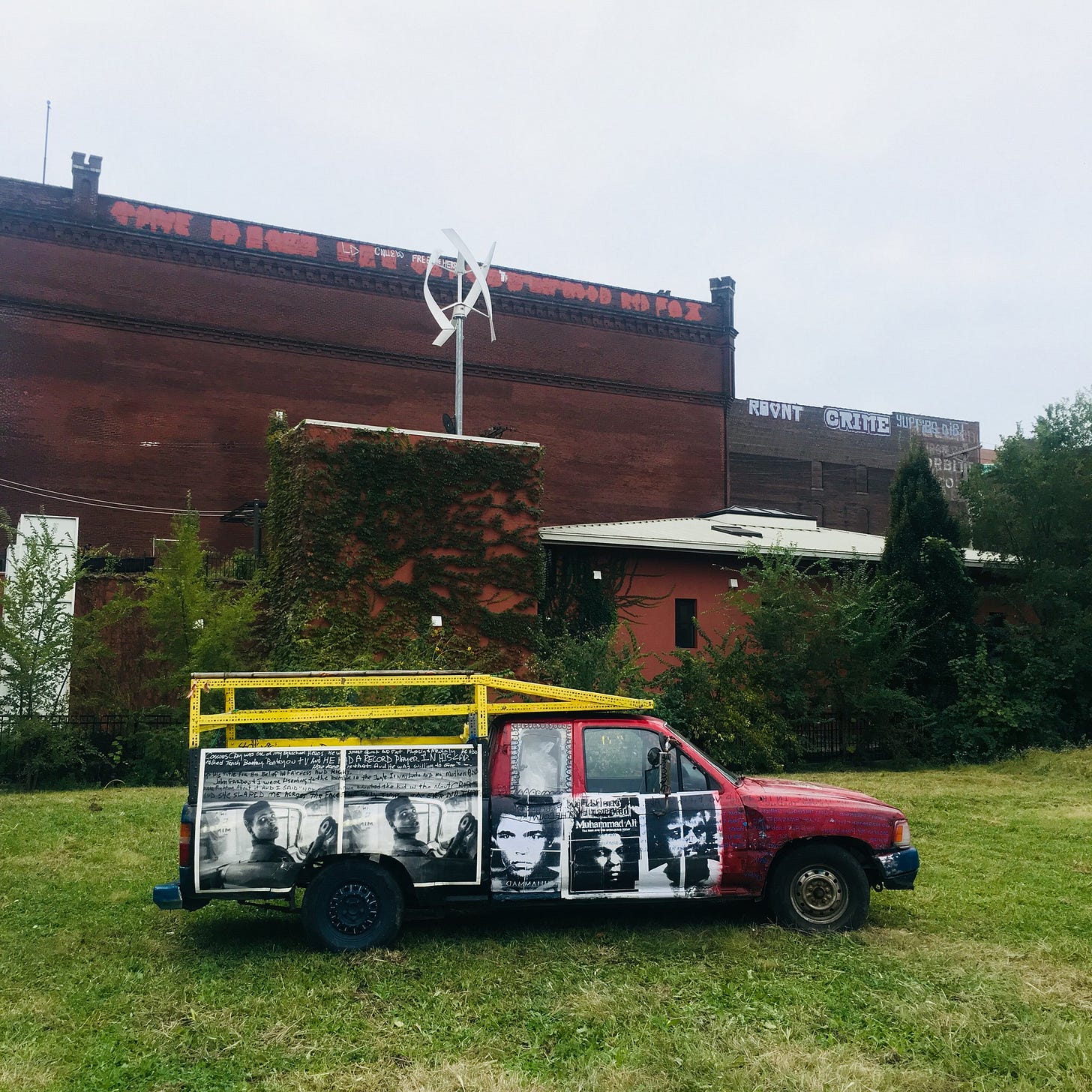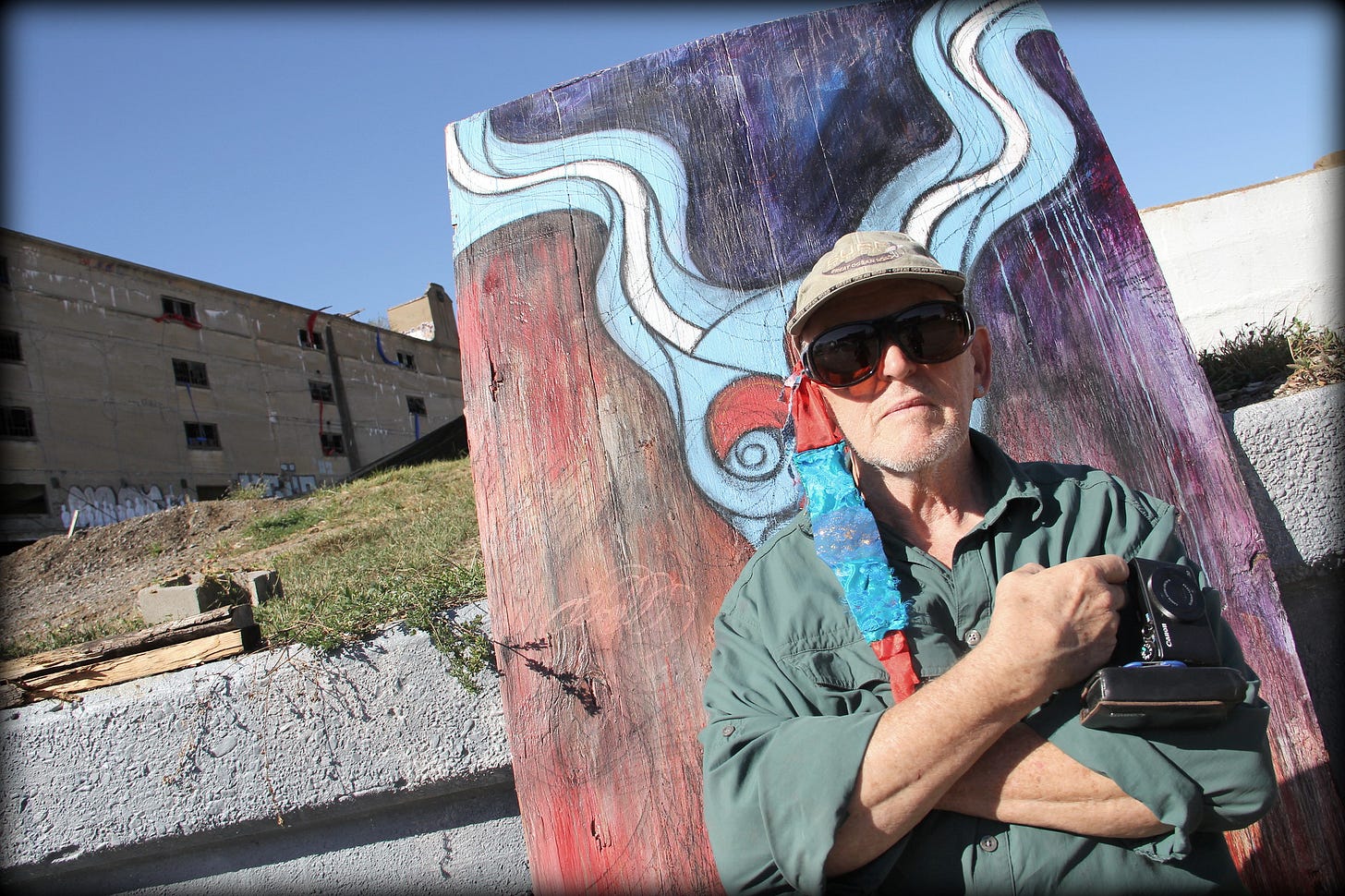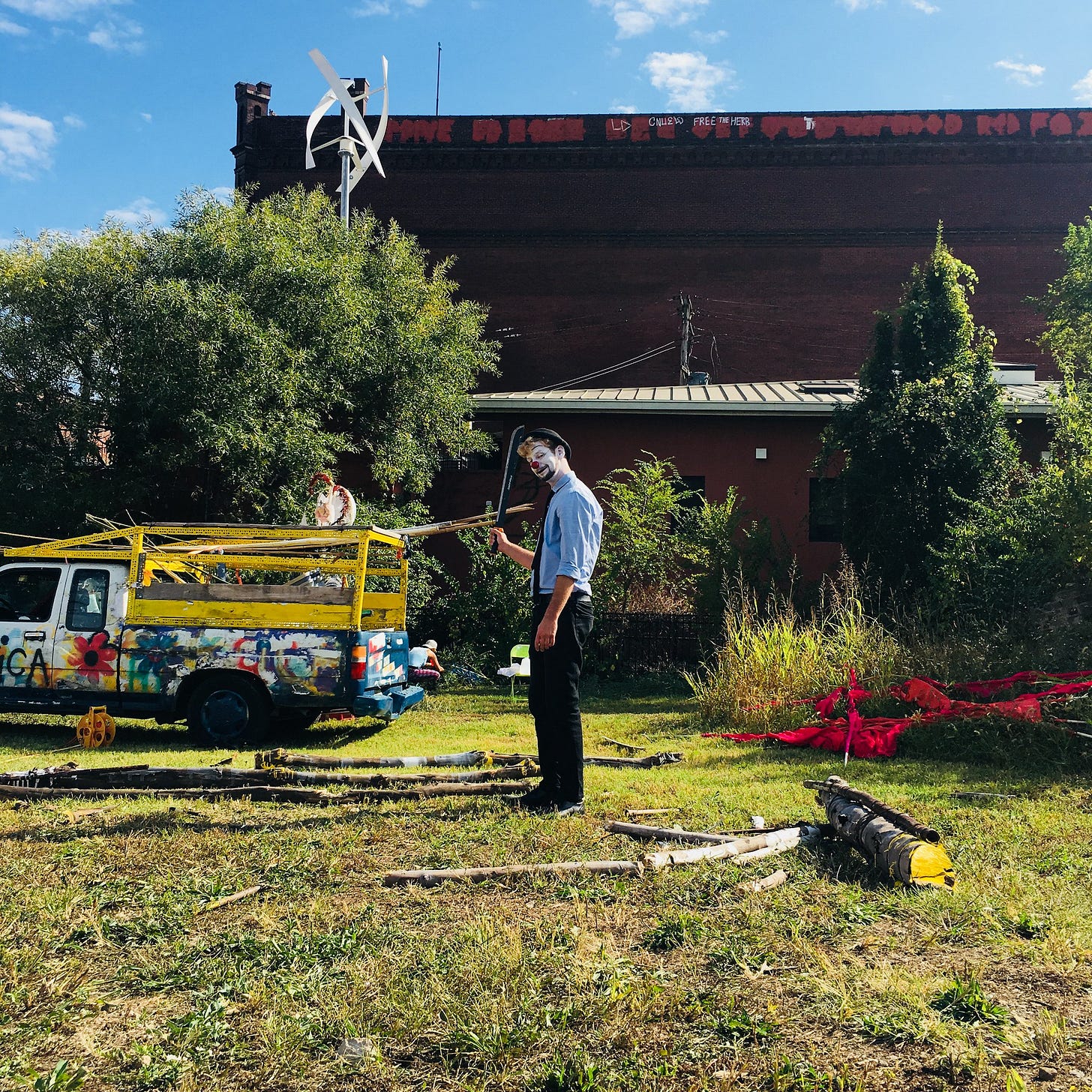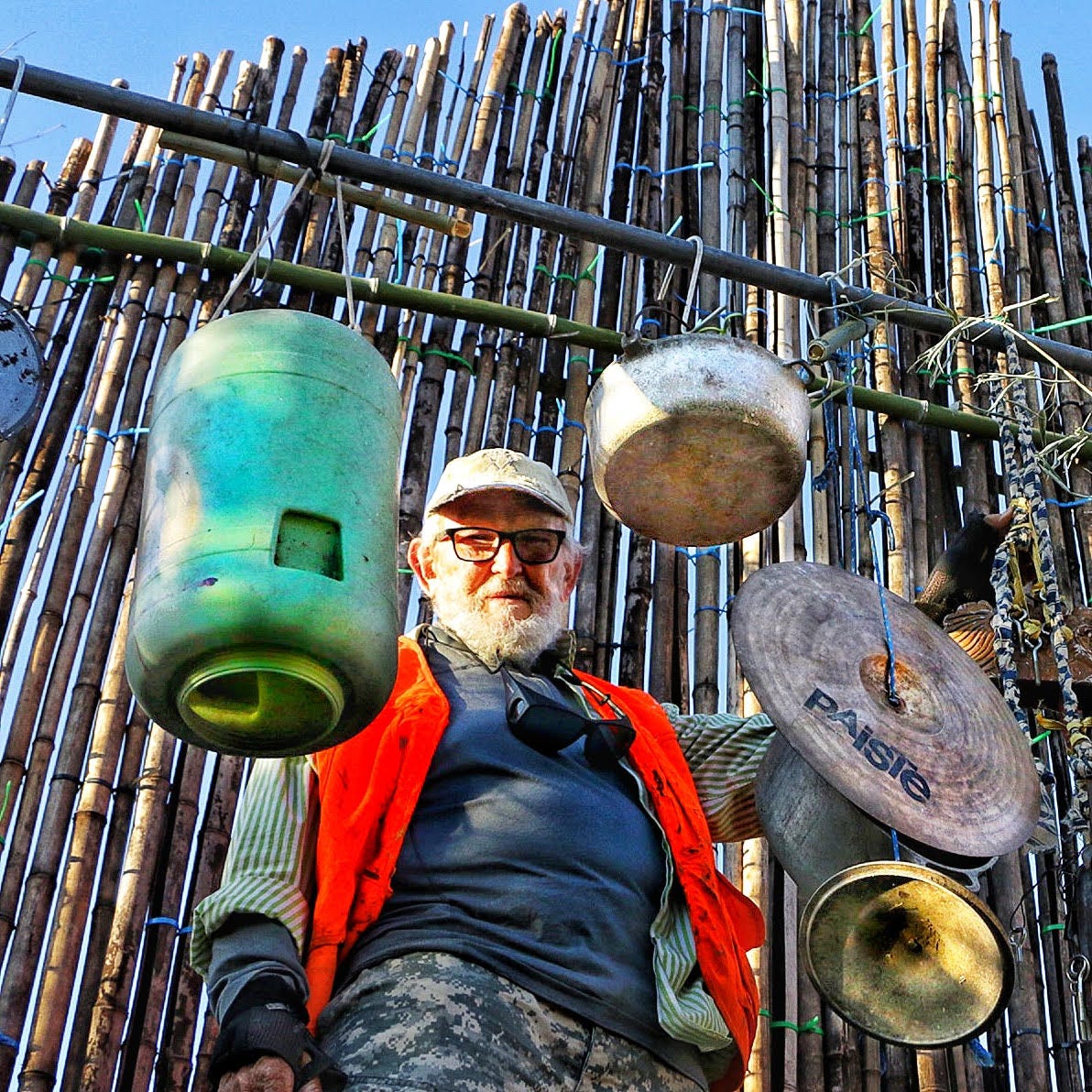This interview took place on December 9, 2022, on a brisk, breezy day outside of the Mud House; we deeply regret the delay in posting. At the time, our subject, Dr. Bill Russell, was a board member of Artica. He was joined by Audrey Simes and her voice occasionally appears during this interview, as well, highlighted in italics. Though the piece has taken on a bit of age, it does give an excellent sense of the earliest days of Artica, catching us up through his engagement with the fest that fall, in 2022.
You were an early member of Artica.
Oh, yeah. I was there before Artica was even founded. It was at a Nada Dada thing that RAC was having. I was doing a painting series up at Jefferson and Washington and I told Nita about it. She looks at me and says “we’re doing something you’ll be interested in. We’re having a meeting in a couple of weeks on a Sunday. Come on down.” At Hap and Nita’s old loft we came up with the idea of Artica. I’m always fuzzy about this, but there was an unofficial Artica before the official (first). That was very early on.
There was just trash down there, everywhere. You came down and built pieces out of what was laying around. It was very anti-establishment. They knew Tim Tucker because they used to live down on Broadway. They’d met Tim and he was really into it. We got a group together and showed up and started doing stuff.
Have you been involved every single year in some sort of way?
Yes. I’ve done almost every year. One year I had to be out of town for a conference. Audrey came down and presented one of my pieces. And Josh (Wolf) wore one of the pairs of particle pants, or “particle entanglement.” It was from a show at RAC. It was an experiment to see if the actions of one pair of pants would affect the other pair of pants, through the particle entanglement. As far as we know, it didn’t work. (Laughs.)
Outside of the weekend of Artica, there have been Blast Off Bangs and Tiny Totem Parades and the like. Which of those, or any of those, stand out as fun, special days?
The guerilla parade that we did down Cherokee one year. Roseanne (Weiss) knew about and surreptitiously mentioned it to the police, so that they could block off the side streets. But no one else knew about it. And that’s sort of the spirit of Artica. We show up with a 24-foot dragonfly mounted to the top of a truck. Drive down the street with a parade.
(Audrey) Was that with the bull…?
I can’t remember if it was before or after. The bull was the same year as a print conference, a graphic arts conference at Wash U, and there was a lot going on there. And we showed up and did a parade for that, too. That was also a big fundraiser for us, too, for Artica. Hap and Lohr built the basic structure of it and lots of people came down and helped paper mache the (bull).
There have also been moments at Fringe Fest and People’s Joy Parade…
(Audrey) We did the very first Fringe Festival, a piece together.
Yeah, the first one was not an Artica piece.
(Audrey) That’s right. It’s what stimulated a relationship with Fringe. The piece we did together.
Right. We did pieces the first couple of years. After that, I invited a lot of the Artica people to come down. I said, “we’ve got this spot. Come down and build anything you want.” After that, we participated in Fringe for a number of years after, officially as Artica. That was our second big event (annually).
(Audrey) The last year being 2019.
It’s 2022. What did you do at Artica in 2022?
This year I had a piece called the Found Sound Orchestra which is sort of a set of cymbals that I play. Audrey and I took a piece from a show we had at RAC, at the Kranzberg. A big bamboo screen and Audrey expanded on that and we mounted it up at one end of the bottom field. And I set up my music rack in front of it. And I broke out the old Pitchey Patchey Man costume and played music and hung around.
In 2020 and 2021, what was the importance of those years in seeing this continue through a pretty challenging period; still throwing a public event?
In 2020, we had an amazing turnout for that one. I wasn’t a fan of doing it that year, but we did it anyway. I did a stealth piece that was up on the mound, right where you come in, which Hap painted one year. I made a trail and mounted some pieces up there. It was my Covid hideout. I did a piece, but not many people knew about it.
I did a couple of stealth pieces. One year I did a big graffiti piece on the west side of the Cotton Belt building, that you had to walk a couple of blocks up from the site to see. It was for the train. I’ve done a couple of pieces for the Amtrak train. (Laughs.)
Same-ish question: is there a moment, or two, or three where you think '“this is why I do this, this is why I’m involved?”
I have a favorite story that I tell all the time. In the second or third year there was still lots of trash being dumped down there. I had a friend, he worked at the library downtown. He told a friend of his who worked at the library. And his friend brought his pre-teen daughter down. We always encourage people to make something to bring down. She had gathered all of these little pieces of broken mirror and that big space between the Cotton Belt Building and the railroad building, when that was all still concrete… well, she laid these pieces all the way down. And that was still one of my favorite pieces that’s ever been built there. That’s what Artica is about. Bringing people to an unexpected place to discover this creative streak in themselves.
Have there been times, being a longtime board member, when you’ve thought “awesome idea, but someone could get hurt. We can’t do this.”
A couple of times. There have been times where we’ve said, “this can’t be done, you have to do this, you can’t do this.” There were requirements on it. So they didn’t do a part of the piece. There was sort of an unwritten rule on the board that if Hap and I both thought it was a great idea we should never do it. (Laughs.) Unless we wanted that to be the last Artica.
Your notions of the blend of new and existing people…
It has certainly changed. Early on there was a sort of storage tank the end had been ripped out of it. Someone turned it into a giant counseling room. There was a piece that was a map of all the pieces. It’s changed. I don’t know if there was even a place to put a (music) stage up, early on. We used to use the flat space next to the Kerr building. Or they’d set up in the Cotton Belt Building. There just wasn’t a space that was flat enough.
Certainly, since Audrey started, the performance aspect has greatly increased. Before it was Johnny Vancouver and maybe a couple of bands would show up. And random musicians would show up. We had a lot of music early. There was a cello player who played with the symphony. He’d always come down and it would be much more experimental. Two or three other musicians would show up and we’d sit around and play. Some people might start dancing. We still have some people who show up like that. Now it’s more formal. We want to give to you money. And you have to go through a couple of things to get money. We have to show RAC what we’ve done.
There are certainly things in which I go and I just view what’s there. It’s an installation and I go and I view it. There are other pieces of work that have been more participatory. Like Lynn (Berg) and Audrey C(rabtree) doing their performances. What’s the blend in your mind that makes it all feel “Artican?”
I’m really a big fan of… well, all of my stuff has been something you can touch or interact with. The Found Sound Orchestra, one of the things of it is that I can give a three-year-old a piece of rod and they can beat the hell out of it. And they have a great time. With just my own personal stuff, because it’s fiber art-based, I want people to touch it, to interact with it. And then it’s a blend. Some things wouldn’t be appropriate for people to handle, as it’d fall over on them.
But I think that it’s always an issue with the board. How to get more people to participate in that way. It’s always something that’s on my mind. Lohr is a perfect example. He’s someone who came down and said “I need to come down and build something here.” He built one of the best pieces down there. He took railroad ties and a big piece of metal and bolted these together and built a giant tripod of railroad ties. He came down, he found what’s down there, he built. The idea of the engineering of this… if something had slipped, someone could’ve died. It’s too bad, in some ways, that those kinds of materials aren’t there any more.
Lohr’s referenced how the space has changed and I remember how rough it was. Was there only year on the riverfront stage?
There was someone who was basically running a scam. They’d bought (the Cotton Belt) from Tim. Turns out they defaulted on the loan and this’n’that. We didn’t have access to it and they were going to turn into a performance venue. So we talked to the port authority, which is basically one guy who decides what happens on the riverfront and he’s like, “oh, this is cool. You guys can do it. We can block it off so the hot-rodders don’t come down.” It was totally the one guy who rules this little kingdom and he liked us. Which is also why nothing ever happens down there because the guy in charge of the port… well, whatever. That was one of my favorite years.
Have there been moments to your recollection of unseasonable heat. Unseasonable cold. Ridiculous rain storms. Even, let’s say… well, I remember the year of The Burn going “whoosh…”
(Audrey) When it blew towards the stage? That was 2017? The burn was on the lower field and the stage was on that road. The fire was raining down on us. It burned the tent and we had to move all the equipment.
Do you recall other events like that?
Oh, yeah. Early on we had some on the summer or winter solstice. I remember so many times… one year it was four- or five-degrees out. That was the year they did Chicken and Waffles. I remember that people would camp out. We’d all sort of go to this used work clothes place; luckily, all of us had heavy-duty long underwear. I remember falling down twice, because I had so many clothes on. I remember being across from the Kerr building, coming down some steps and thinking I was further down than I was and stepped off… normally, you catch yourself. But I had so many clothes on, I couldn’t. I also had so many clothes on that it didn’t hurt. I just fell down.
Another time I was standing and talking to Hap and Nita and was walking away. There was a log next to my leg. I had so many clothes on that I didn’t notice it next to my leg. I took another step and the other leg just didn’t come. Someone had to help me out of this closed-in space…
(Audrey) Like a turtle?
Exactly.
We referenced the Cotton Belt and, of course, there’s the Kerr. Can you kind of address the impact of that building being there?
The Kerr has always been supportive. They’ve supplied us with electricity. They’re our green room now for performers.
(Audrey) That started in 2020. And it was a huge aspect of pulling off the event, itself. And now through their generosity, we’re able to use it as much more than a green room. It’s for volunteers. There’s much more potential. Even in 2020, we started talking about it as a gallery-type space. But that would be anti-Artica. (Laughs.) For now it’s our facility. They’re a huge supporter.
We’ve had many, many fundraisers there. It’s made it — for a lot of people who might hesitant about going down there — people involved in the arts have been there for one fundraiser or another. So they kinda know it. This is not the guerilla artist crowd, but the middle-class arts supporter crowd. I think they’re more willing to come down there, with a sense of knowing the place.
(Audrey) Having talked to John Sweet fairly recently, he feels like one of the last holdouts of that neighborhood. He and the sign company, basically. He speaks about how painful it is to watch the community just dwindle away. He spoke with me about that this year, watching them go one after another. We’re still there, too, and we make a big impact on his community.
One or two last things. At what point in the year do you think about what you’ll present next? Or is it a constant evolution?
I think if it happens in October, there’s usually a little bit of cleaning up the festival. And at the beginning of the year, the holidays are over and we start looking back. We’re starting to apply for grants. Usually there’re also values and other statements (to write), general board work that we do. For the last few years we’ve been trying to do the ground work to grow the organization to the next level up in funding. Having a $50,000 budget instead of a $10,000 budget. And there’s a lot of bureaucratic stuff to do with that. There’s usually a lull from November to January because everybody’s sort of burned out a little bit and it’s the holidays. Nothing happens between Thanksgiving and New Year’s.
Last question. Money. The role of money in any of this. I don’t wanna say it’s been a stress point, but I think there’s been a moment of “let’s do this with as little money as possible” and other times when…
There was one year when Artica was on all the college radars. The Burn was almost scary, there were so many people. We didn’t even apply for grants the next year. We did this little, small Artica. Talk about hot ones, this was a summer solstice one and one of the pieces was Hap and Nita bringing down a wading pool with a little fountain in it. And I actually made a movie of it that got into the experimental movie festival of The Pulitzer that year. That was the essence of it. My camera was a little pocket camera in a plastic bag so that it wouldn’t get wet. It was a three-minute movie and a perfect example of Artica. Early one, we probably didn’t have any money. The first year Audrey participated, I think, we had enough money to give all the artists $100. So I remember her as a student at Webster and I showed up with $100 check and it was “like, what you get money for this?” So I’m guessing we were we the first folks to pay you for a dance performance.
(Audrey) For performance art.
Yup, performance art.
A link to Dr. Bill Russell’s homepage.
-30-

